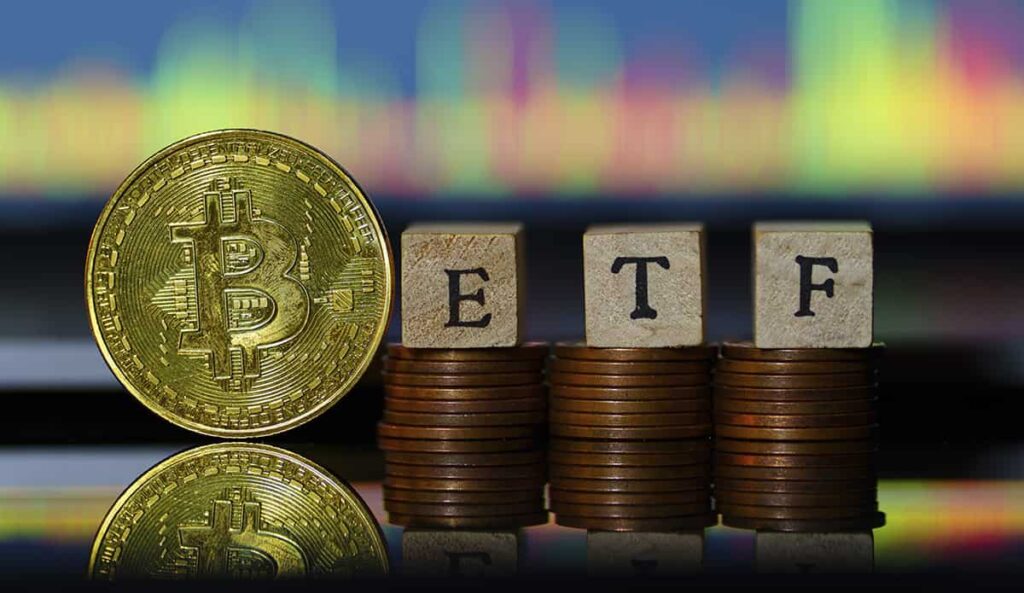Disclaimer
This article is for informational and educational purposes only and should not be construed as financial or investment advice. The value of cryptocurrencies and related financial products can be highly volatile and involves significant risk. You should consult with a qualified, licensed financial advisor to determine if an investment in a Bitcoin ETF is suitable for your individual financial situation and risk tolerance.
What Is a Bitcoin ETF? An Investor’s Guide
For years, investors sought a way to gain exposure to Bitcoin’s price movements without navigating the technical complexities of cryptocurrency exchanges and digital wallets. The introduction of spot Bitcoin ETFs (Exchange-Traded Funds) provides a solution, bridging the gap between traditional finance and the world of digital assets.

This guide provides a clear and objective overview of what a spot Bitcoin ETF is, how it operates, and the key advantages and risks investors must consider.
First, What Is an Exchange-Traded Fund (ETF)?
Before diving into the specifics of Bitcoin, it’s essential to understand the underlying investment vehicle. An Exchange-Traded Fund (ETF) is a type of investment fund that is traded on a stock exchange, much like a regular stock. According to the U.S. Securities and Exchange Commission (SEC), an ETF holds assets such as stocks, bonds, or commodities, and its shares represent an ownership stake in that pool of assets.
Defining the Spot Bitcoin ETF
A spot Bitcoin ETF is a fund that directly holds actual Bitcoin as its underlying asset. The primary goal of the ETF is to track the real-time market price (the “spot” price) of Bitcoin.
- When the market price of Bitcoin increases, the value of the ETF’s shares is designed to increase proportionally.
- Conversely, when Bitcoin’s price decreases, the ETF’s share value also decreases.
Think of it this way: instead of purchasing a physical asset like a gold bar and worrying about its storage and security, you can buy a share in a fund that holds a large quantity of gold in a secure, audited vault. A spot Bitcoin ETF applies this same principle to Bitcoin. A major financial institution buys and holds a substantial amount of Bitcoin, and investors can purchase shares of that fund through their standard brokerage accounts.
How Do Spot Bitcoin ETFs Operate?
The operation of a spot Bitcoin ETF involves several key players working in a regulated ecosystem:
- The Issuer: A large, trusted asset management firm (such as BlackRock, Fidelity, or Grayscale) creates and manages the fund.
- Bitcoin Custody: The issuer partners with a specialized custodian (like Coinbase Custody) to securely store the fund’s massive Bitcoin holdings using advanced security protocols.
- Share Creation and Redemption: The issuer works with authorized participants to create new ETF shares when there is high demand and redeem them when demand falls. This mechanism helps ensure the ETF’s market price stays closely aligned with the actual price of Bitcoin.
- Public Trading: The ETF shares are listed on a major stock exchange, like the NYSE or Nasdaq, where they can be bought and sold by retail and institutional investors throughout the trading day.
Advantages of Investing in a Bitcoin ETF
For many investors, particularly those new to cryptocurrency, ETFs offer several distinct advantages over direct ownership.
- Simplicity and Accessibility: You can buy and sell shares of a Bitcoin ETF through your existing brokerage or retirement account (e.g., an IRA or 401(k)), just as you would with any stock. This eliminates the need to sign up for a cryptocurrency exchange or learn new platforms.
- No Self-Custody Required: The responsibility of securing the Bitcoin—managing private keys, using hardware wallets, and preventing theft—is handled by professional custodians. This removes a significant technical barrier and security risk for investors.
- Regulatory Oversight: Bitcoin ETFs are regulated financial products. Their approval by the SEC in January 2024 was a landmark event, providing a level of investor protection and market legitimacy that was previously unavailable.
Risks and Key Considerations
Despite the benefits, investing in a Bitcoin ETF carries inherent risks and trade-offs that every investor must understand.
- No Direct Ownership (“Not Your Keys, Not Your Coins”): This is a fundamental principle in the cryptocurrency community. When you own shares in an ETF, you own a security that tracks Bitcoin’s price; you do not own the underlying Bitcoin. You cannot use it for transactions, send it to another wallet, or participate in the broader crypto ecosystem.
- Management Fees (Expense Ratios): Issuers charge an annual management fee, known as an expense ratio, to cover the costs of operating the fund, including custody and administration. While competitive, this fee will slightly reduce your overall returns over time.
- Limited Trading Hours: Unlike the 24/7 nature of cryptocurrency markets, Bitcoin ETFs can only be traded during the standard hours of the stock market (e.g., 9:30 AM to 4:00 PM ET, Monday-Friday). This means you cannot react to significant price movements that occur overnight or on weekends.
- Tracking Error: While ETFs are designed to track Bitcoin’s price closely, there can be minor discrepancies known as tracking error, where the ETF’s price deviates slightly from the underlying asset’s price.
Final Thoughts: Convenience vs. Control
Ultimately, the decision to invest in a spot Bitcoin ETF or buy Bitcoin directly depends on your personal investment goals, technical comfort level, and philosophy on asset ownership.
- Choose a Bitcoin ETF if: You prioritize convenience and want simple price exposure within the regulated and familiar environment of your traditional investment portfolio.
- Buy Bitcoin directly if: You prioritize self-sovereignty and control, want to hold the actual asset, desire 24/7 market access, and wish to have the ability to use your Bitcoin for transactions.
Both methods offer valid ways to engage with the asset, but they serve different needs. Understanding this distinction between convenience and control is the first step toward making an informed investment decision.
About the Author
Alex Carter is a Crypto Content Specialist who has been writing about technology and finance for over five years. With a background in breaking down complex systems, Alex focuses on making the world of blockchain and decentralized finance accessible to everyone. You can find more of their work on this site or connect with them on X (formerly Twitter) and LinkedIn.





